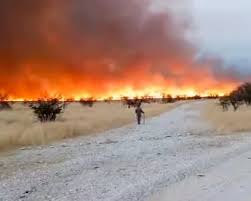Namibia has launched a large-scale emergency operation, deploying helicopters and more than 500 soldiers to fight a raging wildfire that has swept through Etosha National Park, one of southern Africa’s most iconic wildlife reserves. The fire, which authorities believe started last Monday at a charcoal production site outside the park’s borders, has already destroyed nearly a third of the protected area, threatening biodiversity, wildlife habitats, and surrounding communities.
Etosha National Park, covering 22,935 square kilometers (8,855 square miles), is one of Africa’s largest and most renowned nature reserves. Known globally for its vast salt pan visible from space, the park attracts around 200,000 tourists annually and is home to an extraordinary array of wildlife, including the critically endangered black rhino, elephants, lions, giraffes, cheetahs, and over 114 mammal species, as well as hundreds of migratory bird species such as flamingos.
According to Namibia’s Ministry of Environment, Forestry and Tourism, the wildfire has spread rapidly due to strong winds and dry vegetation, consuming hundreds of thousands of hectares of grazing land both inside the park and in neighboring regions bordering Angola. At least nine antelopes have already been killed, and experts fear the true toll on wildlife may be far higher as the flames continue to destroy fragile ecosystems.
Prime Minister Tjitunga Elijah Ngurare announced on Saturday that more than 500 troops would be sent to assist firefighters, police officers, and local volunteers who have been battling the blaze for nearly a week. Helicopters are being used to monitor and suppress fire fronts, while ground teams work tirelessly to contain hotspots. The presidency confirmed late Sunday that fires in surrounding regions—including Oshikoto, Oshana, and Kunene—were brought under control, though the full extent of the destruction in Etosha will only be known once aerial surveys and satellite imagery are completed.
“The fire poses a significant threat to the biodiversity, wildlife, and livelihood of the communities in the affected areas,” the presidency said in a statement, adding that approximately 30% of grazing areas inside the park have been destroyed. Thankfully, no human casualties have been reported.
The crisis has drawn criticism from opposition lawmakers, with MP Likando Rodrick accusing the government of being unprepared for such a large-scale disaster and urging stronger long-term strategies to manage recurring wildfires. Experts note that while wildfires are a natural phenomenon in Namibia’s arid savannah landscape and can help rejuvenate ecosystems when managed, uncontrolled fires of this scale threaten endangered species and undermine conservation efforts.
The urgency of the government’s intervention reflects the park’s significance not only as a national treasure but also as a cornerstone of Namibia’s tourism economy. With the park’s unique biodiversity and habitats under threat, conservationists warn that recovery could take years if the damage is not quickly contained.
As emergency teams continue their efforts, Namibia’s response to the Etosha fire is being closely watched by conservationists across Africa. The outcome will determine not only the future of one of the continent’s most important protected areas but also the livelihoods of surrounding communities who rely on the park’s tourism and grazing lands.














Leave a comment